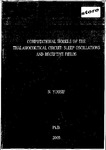Computational models of the thalamocortical circuit: sleep oscillations and receptive fields.
| dc.contributor.supervisor | Denham, Mike | |
| dc.contributor.author | Yousif, Nada | |
| dc.contributor.other | Faculty of Science and Engineering | en_US |
| dc.date.accessioned | 2012-08-22T11:16:46Z | |
| dc.date.available | 2012-08-22T11:16:46Z | |
| dc.date.issued | 2005 | |
| dc.identifier | Not available | en_US |
| dc.identifier.uri | http://hdl.handle.net/10026.1/1161 | |
| dc.description.abstract |
The thalamus is a subcortical structure, which consists of a collection of functionally and morphologically defined nuclei. A subset of these, the sensory nuclei, receive information from the periphery and relay it to the related primary cortical area. Hence the thalamus was traditionaUy assumed to passively relay afferent information. However, the fact that thalamic relay cells receive a large proportion of their sjoiaptic inputs from the cortical cells to which they project, has led to the consensus that there is a more significant thalamic contribution to sensory processing. This thesis investigates the role of the thalamocortical feedback loop using population-level computational models. In particular two states of thalamocortical activity are investigated: early sleep, and active visual processing. During early sleep, the network displays 7-14Hz spindle oscillations. These osciUations have been previously modelled using conductance-based paradigms, but here the activity is investigated through the nonhnear dynamics of the circuitry. It is shown that the circuit has an intrinsic resonant frequency in the spindles range. During visual processing, the role of the lateral geniculate nucleus (the primary visual thalamic nucleus) was previously overlooked, as thalamic receptive fields are spatially identical to those in the retina. Temporally however, thalamic and retinal responses differ in magnitude, and the second model in this thesis shows how cortical feedback can have a role in augmenting thalamic temporal responses. This model was reduced in order to find the minimal thalamic circuitry that can produce such responses, and this final model can also exhibit steady state oscillatory behaviour. The transition from transient visual activity to sustained oscillatory activity in this model, required a switch in the relative cortical feedback weights to the thalamocortical and the reticular populations. Together, these results indicate that the contribution of the thalamus to neural activity can no longer be ignored. | en_US |
| dc.language.iso | en | en_US |
| dc.publisher | University of Plymouth | en_US |
| dc.title | Computational models of the thalamocortical circuit: sleep oscillations and receptive fields. | en_US |
| dc.type | Thesis | en_US |
| plymouth.version | Full version | en_US |
| dc.identifier.doi | http://dx.doi.org/10.24382/1293 |
Files in this item
This item appears in the following Collection(s)
-
01 Research Theses Main Collection
Research Theses Main


